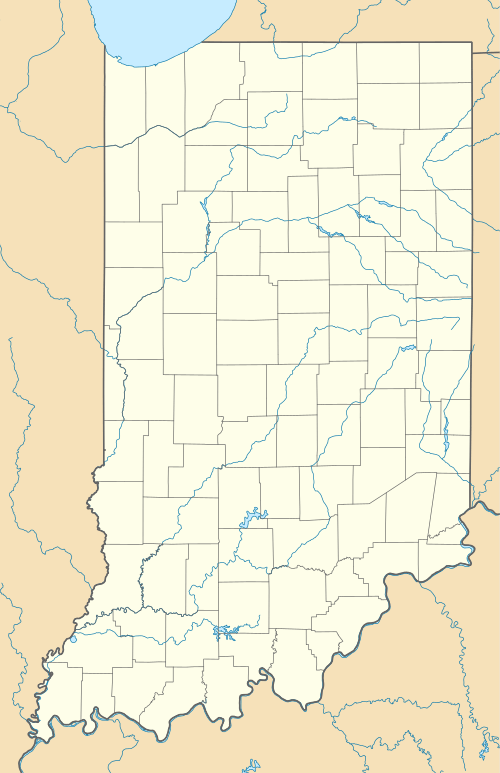David Garland Rose House
|
David Garland Rose House | |
|
summer 2010 | |
  | |
| Location | 156 Garfield St., Valparaiso, Indiana |
|---|---|
| Coordinates | 41°27′58″N 87°3′5″W / 41.46611°N 87.05139°WCoordinates: 41°27′58″N 87°3′5″W / 41.46611°N 87.05139°W |
| Area | less than one acre |
| Built | 1860 |
| Architect | Rose,David Garland |
| Architectural style | Gothic Revival, Octagonal Mode |
| NRHP Reference # | 80000030[1] |
| Added to NRHP | July 17, 1980 |
The David Garland Rose House was built circa 1860 in Valparaiso, Indiana, United States. David Rose was a local businessman. This Gothic Revival house is unusual in that it is eight-sided, an octagon. Each of the eight gables include decorated wood panels. Covered porches have been added to three sides.
The octagon house rose in popularity in 1849 with the publication of Orson Squire Fowler's book A Home For All. The idea was to develop affordable and comfortable housing for the working class. Fowler proposed the use of concrete due to its long life and low cost. Most octagon houses are of wood or brick construction. The "octagon craze" was short-lived and pre-dates the American Civil War. Fewer than 120 octagon houses survive.[2]
David Rose
David Rose was a successful business man in Valparaiso. At the start of the American Civil War, he was appointed as Colonel Rose, Commandant of the 54th Indiana Volunteer Infantry at Camp Morton, Indiana.[3]
Design
The Rose Octagonal House is a two-story octagon house of frame construction. The exterior is covered with clapboard siding. Each of the eight sides has a gable roof. A brick chimney runs up the center of the house. The Gothic Revival design is evident in the leaf like pendants cut into its bargeboard trim. Also of Gothic design is a four pointed design at the peak of each gable.[4]
Each one of the eight sides is exactly 12' 2" or 12.1666 feet (3.7084 m) long. A one-story porch, added at a later date, runs the length of the front face. An addition had been added to the back of the house. The addition was two stories with an attached garage.[5] The interior has all the original casings for the doors and windows. The floor has been replaced with narrow tongue and groove oak.[4]
Significance
The David Garland Rose House is architecturally important because of its rare octagonal design, combined with its one-of-a-kind treatment of the roof. Constructed about 1860, the house's octagonal design resulted from a short-lived style popularized by Orson Squire Fowler's, A Home for All or the Gravel Wall and Octagonal Mode of Building, published in 1848. Octagon-shaped houses are rare in Indiana. Less than a dozen are known to be extant.[4] Unlike other octagonal houses in Indiana, each side of the Rose House is gabled, and the eight gabled roofs meet at the center.[4]
References
- ↑ National Park Service (2009-03-13). "National Register Information System". National Register of Historic Places. National Park Service.
- ↑ "David Garland Rose House - Valparaiso, IN 1860 - Octagon Buildings on". Waymarking.com. Retrieved 2012-08-09.
- ↑ "Camp Morton - Civil War Camp and Union Prison - Indianapolis, IN - 1861-1865". Freepages.history.rootsweb.ancestry.com. Retrieved 2012-08-09.
- 1 2 3 4 "Indiana State Historic Architectural and Archaeological Research Database (SHAARD)" (Searchable database). Department of Natural Resources, Division of Historic Preservation and Archaeology. Retrieved 2016-06-01. Note: This includes H. Ronald Knight (August 1979). "National Register of Historic Places Inventory Nomination Form: David Garland Rose House" (PDF). Retrieved 2016-06-01. and Accompanying photographs.
- ↑ Visual inspection when photographed, see image file, 2007


